Ocean Surface Gravity Wave Evolution during Three Along-Shelf Propagating Tropical Cyclones: Model’s Performance of Wind-Sea and Swell
Abstract
:1. Introduction
2. Study Area and the TCs of Interest
3. Numerical Model Description and Setup
3.1. Ocean Model (ROMS)
3.2. Wave Model (SWAN)
3.3. Model Coupling Scheme
3.4. Model Setup
4. Model Verification
5. Wave Spectrogram and Directional Wave Spectrum Evolution
5.1. Sea–Swell Seperation Frequency
5.2. Wave Spectrogram Behavior
5.2.1. Wave Evolution Phases Associated with the TCs
5.2.2. Phase D (Disturbance): Dominance of Northeasterly Wind by a Continental Cold High during Matthew
5.2.3. SWAN Model’s Performance for Wave Energy Spectrogram
5.3. Directional Wave Spectra
6. Discussion
6.1. Use of Wind-Sea–Swell Seperation Frequencies
6.2. Effect of Atmospheric Conditions on Wave Spectrograms
6.3. Effect of TC Translation Speed on Wave Energy Distribution
6.4. Formation of Multi-Modal Directional Wave Spectra
6.5. Model’s Performance on Wave Energy Distribution
7. Conclusions
Author Contributions
Funding
Institutional Review Board Statement
Informed Consent Statement
Data Availability Statement
Acknowledgments
Conflicts of Interest
Appendix A
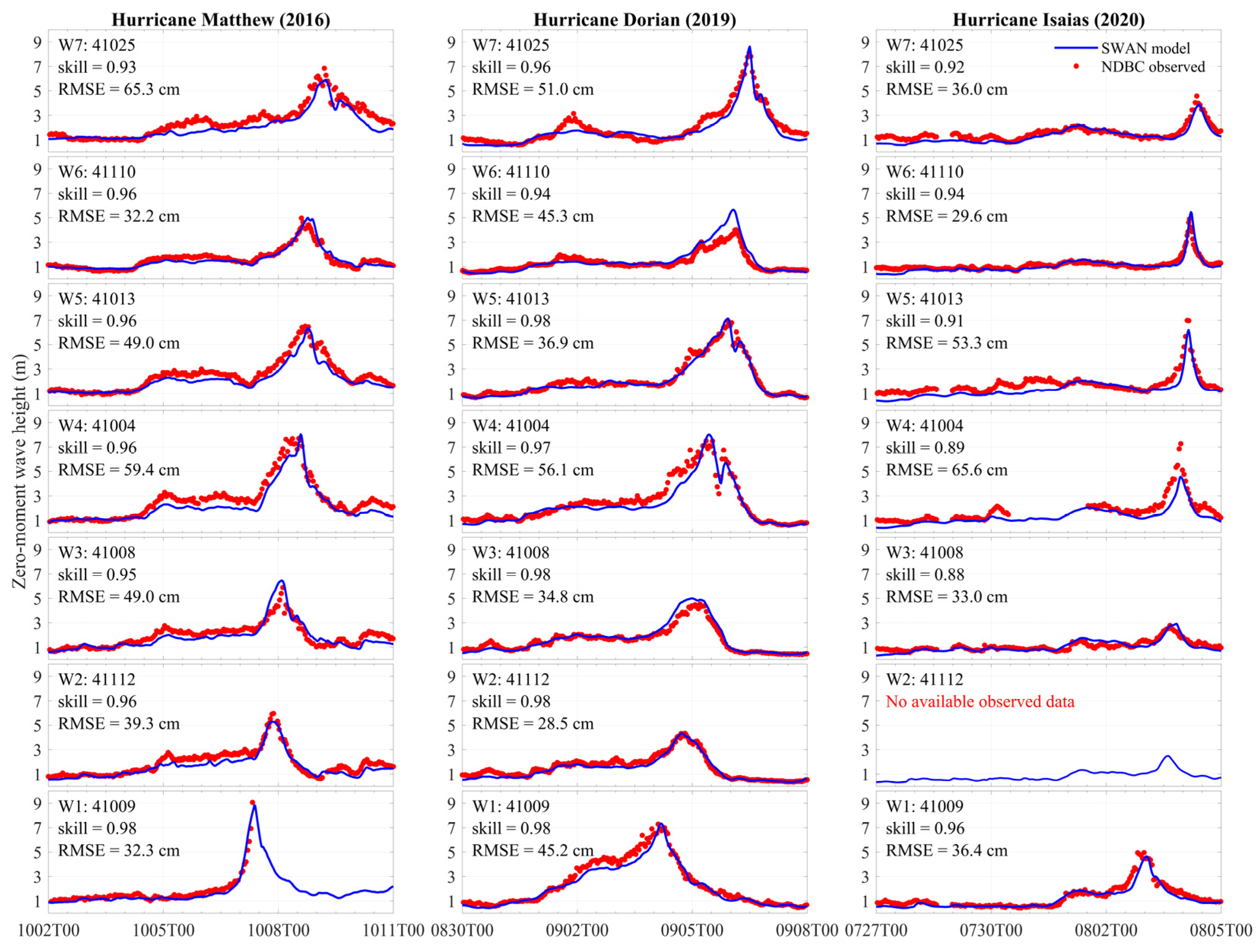
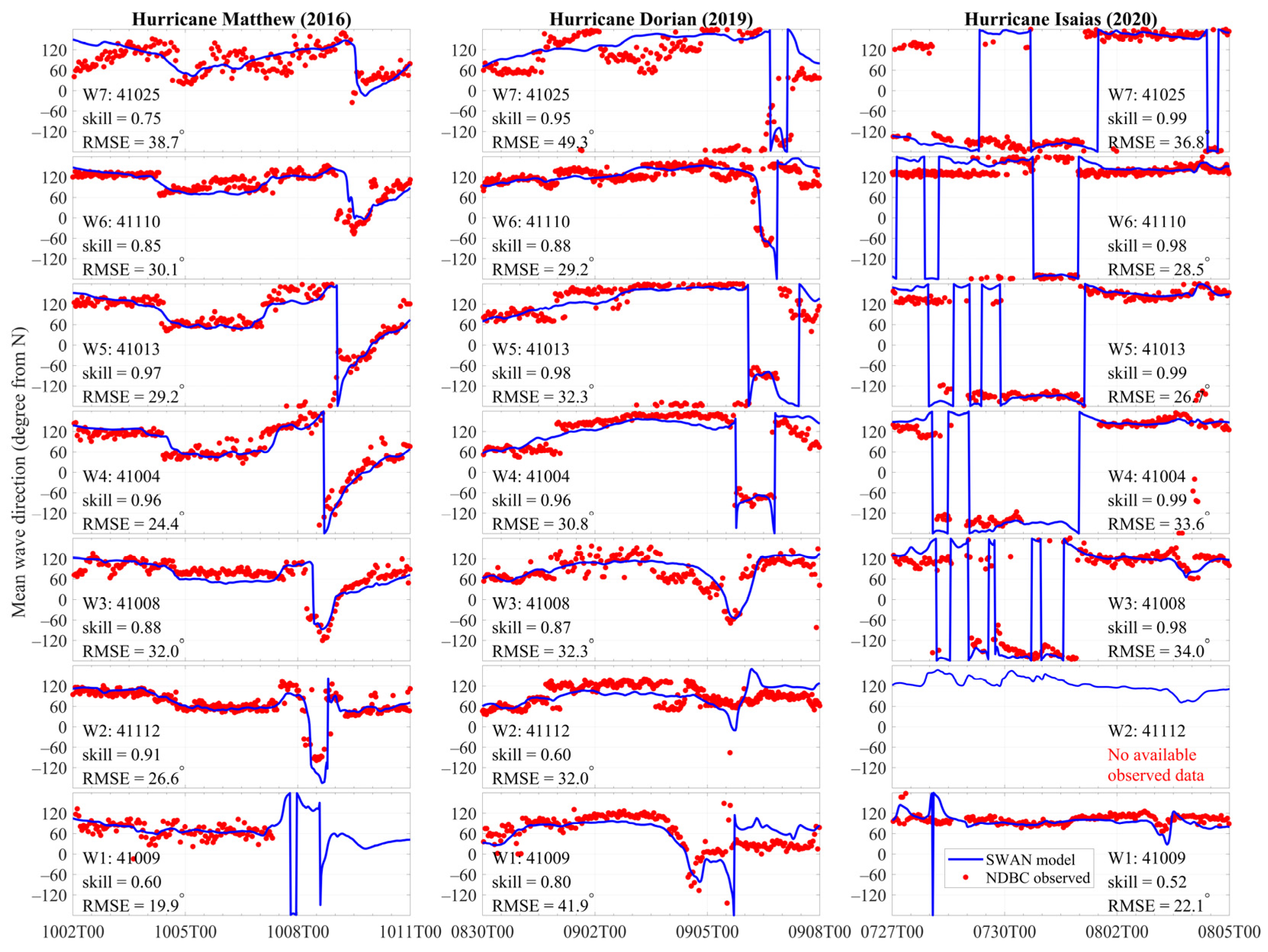
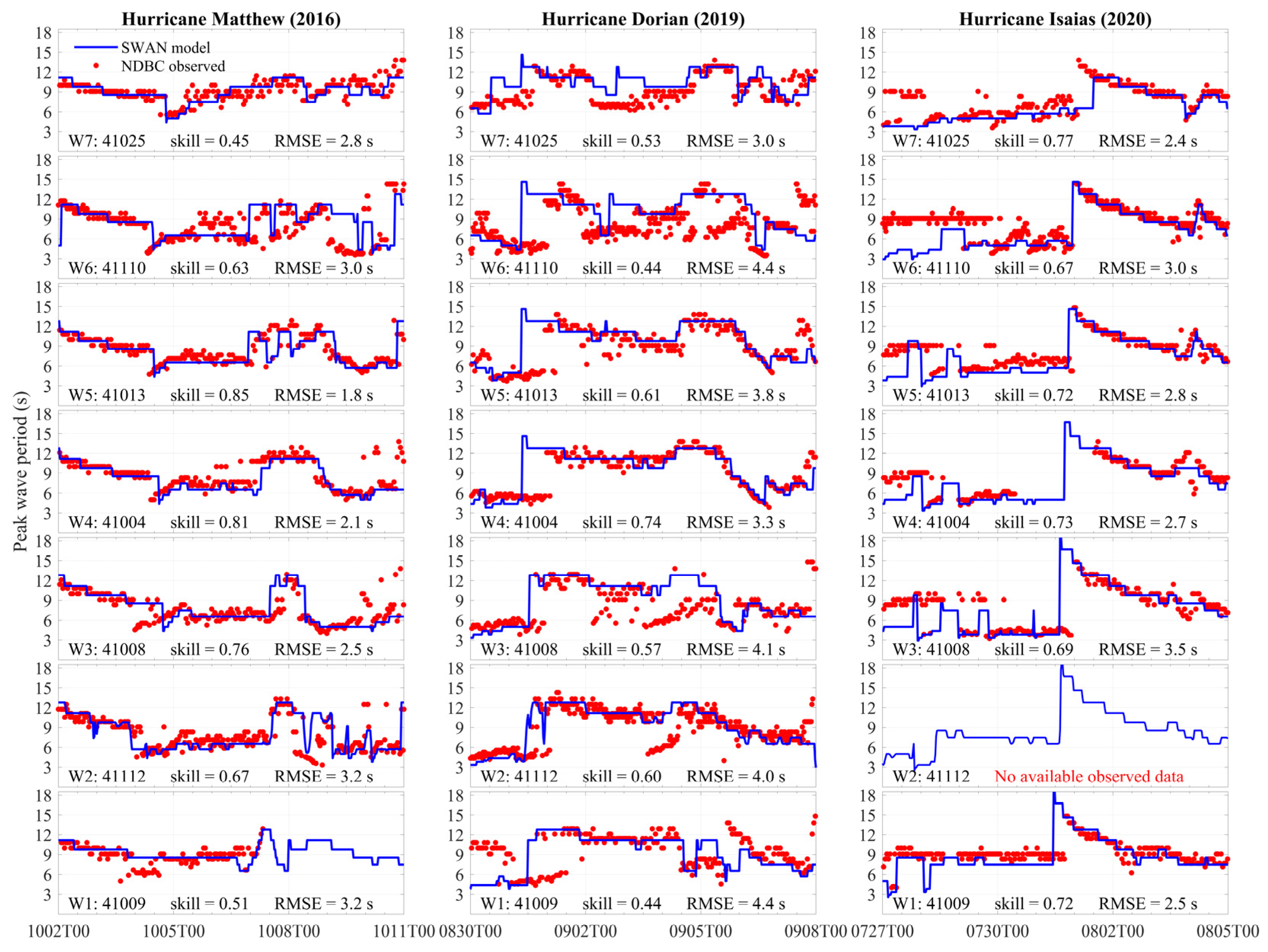
References
- Stockdon, H.F.; Holman, R.A.; Howd, P.A.; Sallenger, A.H., Jr. Empirical parameterization of setup, swash, and runup. Coast. Eng. 2006, 53, 573–588. [Google Scholar] [CrossRef]
- Hsu, C.-E.; Serafin, K.; Yu, X.; Hegermiller, C.A.; Warner, J.C.; Olabarrieta, M. Total water levels along the South Atlantic Bight during three along–shelf propagating tropical cyclones: Relative contributions of storm surge and wave runup. Nat. Hazards Earth Syst. Sci. Discuss (Prepr. Rev.) 2023, 2023, 1–31. [Google Scholar] [CrossRef]
- National Oceanic and Atmospheric Administration. National Coastal Population Report: Population Trends from 1970 to 2010. NOAA State of the Coast Report Series. 2013. Available online: https://coast.noaa.gov/digitalcoast/training/population-report.html (accessed on 23 May 2023).
- Masson Delmotte, V.; Zhai, P.; Pirani, A.; Connors, S.L.; Péan, C.; Berger, S.; Caud, N.; Chen, Y.; Goldfarb, L.; Gomis, M.I.; et al. Climate Change 2021: The Physical Science Basis. Contribution of Working Group I to the Sixth Assessment Report of the Intergovernmental Panel on Climate Change. 2021. Available online: https://www.ipcc.ch/report/ar6/wg1/ (accessed on 23 May 2023).
- Young, I.R. Directional spectra of hurricane wind waves. J. Geophys. Res. Ocean. 2006, 111, C08020. [Google Scholar] [CrossRef]
- Nair, M.A.; Kumar, V.S.; George, V. Evolution of wave spectra during sea breeze and tropical cyclone. Ocean. Eng. 2021, 219, 108341. [Google Scholar] [CrossRef]
- Wang, D.W.; Hwang, P.A. An operational method for separating wind sea and swell from ocean wave spectra. J. Atmos. Ocean. Technol. 2001, 18, 2052–2062. [Google Scholar] [CrossRef]
- Hwang, P.A.; Ocampo Torres, F.J.; Garcia Nava, H. Wind sea and swell separation of 1D wave spectrum by a spectrum integration method. J. Atmos. Ocean. Technol. 2012, 29, 116–128. [Google Scholar] [CrossRef]
- Potter, H. Swell and the drag coefficient. Ocean. Dyn. 2015, 65, 375–384. [Google Scholar] [CrossRef]
- Gilhousen, D.B.; Hervey, R. Improved estimates of swell from moored buoys. In Proceedings of the Fourth International Symposium WAVES 2001; ASCE: Alexandria, VA, USA, 2001. Available online: https://ascelibrary.org/doi/pdf/10.1061/40604%28273%2940 (accessed on 23 May 2023).
- Ewans, K.C.; Bitner Gregersen, E.M.; Soares, C.G. Estimation of wind–sea and swell components in a bimodal sea state. J. Offshore Mech. Arct. Eng. 2006, 128, 265–270. [Google Scholar] [CrossRef]
- Moon, I.J.; Ginis, I.; Hara, T.; Tolman, H.L.; Wright, C.W.; Walsh, E.J. Numerical simulation of sea surface directional wave spectra under hurricane wind forcing. J. Phys. Oceanogr. 2003, 33, 1680–1706. [Google Scholar] [CrossRef]
- Esquivel Trava, B.; Ocampo Torres, F.J.; Osuna, P. Spatial structure of directional wave spectra in hurricanes. Ocean. Dyn. 2015, 65, 65–76. [Google Scholar] [CrossRef]
- Collins, C.O.; Potter, H.; Lund, B.; Tamura, H.; Graber, H.C. Directional wave spectra observed during intense tropical cyclones. J. Geophys. Res. Ocean. 2018, 123, 773–793. [Google Scholar] [CrossRef]
- Booij, N.; Ris, R.C.; Holthuijsen, L.H. A third–generation wave model for coastal regions—1. Model description and validation. J. Geophys. Res. Ocean. 1999, 104, 7649–7666. [Google Scholar] [CrossRef]
- Rogers, W.E.; Van Vledder, G.P. Frequency width in predictions of windsea spectra and the role of the nonlinear solver. Ocean. Model. 2013, 70, 52–61. [Google Scholar] [CrossRef]
- Shchepetkin, A.F.; McWilliams, J.C. The regional oceanic modeling system (ROMS): A split–explicit, free–surface, topography–following–coordinate oceanic model. Ocean. Model. 2005, 9, 347–404. [Google Scholar] [CrossRef]
- Warner, J.C.; Sherwood, C.R.; Signell, R.P.; Harris, C.K.; Arango, H.G. Development of a 3-dimensional, regional, coupled wave, current, and sediment–transport model. Comput. Geosci. 2008, 34, 1284–1306. [Google Scholar] [CrossRef]
- Warner, J.C.; Armstrong, B.; He, R.; Zambon, J.B. Development of a Coupled Ocean–Atmosphere–Wave–Sediment Transport (COAWST) Modeling System. Ocean. Model. 2010, 35, 230–244. [Google Scholar] [CrossRef]
- Hsu, C.-E.; Hsiao, S.-C.; Hsu, J.-T. Parametric analyses of wave–induced nearshore current system. J. Coast. Res. 2017, 33, 795–801. [Google Scholar] [CrossRef]
- Thomas, A.; Dietrich, J.C.; Asher, T.G.; Bell, M.; Blanton, B.O.; Copeland, J.H.; Cox, A.T.; Dawson, C.N.; Fleming, J.G.; Luettich, R.A. Influence of storm timing and forward speed on tides and storm surge during Hurricane Matthew. Ocean. Model. 2019, 137, 1–19. [Google Scholar] [CrossRef]
- Kumar, N.; Voulgaris, G.; Warner, J.C.; Olabarrieta, M. Implementation of the vortex force formalism in the coupled ocean–atmosphere–wave–sediment transport (COAWST) modeling system for inner shelf and surf zone applications. Ocean. Model. 2012, 47, 65–95. [Google Scholar] [CrossRef]
- Olabarrieta, M.; Warner, J.C.; Kumar, N. Wave–current interaction in Willapa Bay. J. Geophys. Res. Ocean. 2011, 116, C12014. [Google Scholar] [CrossRef]
- Hegermiller, C.A.; Warner, J.C.; Olabarrieta, M.; Sherwood, C.R. Wave–current interaction between Hurricane Matthew wave fields and the Gulf Stream. J. Phys. Oceanogr. 2019, 49, 2883–2900. [Google Scholar] [CrossRef]
- Wang, K.; Hou, Y.; Li, S.; Du, M.; Chen, J.; Lu, J. A comparative study of storm surge and wave setup in the East China Sea between two severe weather events. Estuar. Coast. Shelf Sci. 2020, 235, 106583. [Google Scholar] [CrossRef]
- Gramcianinov, C.B.; Campos, R.M.; de Camargo, R.; Hodges, K.I.; Soares, C.G.; da Silva Dias, P.L. Analysis of Atlantic extratropical storm tracks characteristics in 41 years of ERA5 and CFSR/CFSv2 databases. Ocean. Eng. 2020, 216, 108111. [Google Scholar] [CrossRef]
- Chen, Z.; Zhang, L.; Zhao, C.; Chen, X.; Zhong, J. A practical method of extracting wind sea and swell from directional wave spectrum. J. Atmos. Ocean. Technol. 2015, 32, 2147–2159. [Google Scholar] [CrossRef]
- Stewart, S.R. Tropical Cyclone Report: Hurricane Matthew. Hurricane Center Report. 2017. Available online: https://www.nhc.noaa.gov/data/tcr/AL142016_Matthew.pdf (accessed on 23 May 2023).
- Avila, L.A.; Stewart, S.R.; Berg, R.; Hagen, A.B. Tropical Cyclone Report: Hurricane Dorian. National Hurricane Center Report. 2020. Available online: https://www.nhc.noaa.gov/data/tcr/AL052019_Dorian.pdf (accessed on 23 May 2023).
- Latto, A.; Hagen, A.; Berg, R. Tropical Cyclone Report: Hurricane Isaias. National Hurricane Center Report. 2021. Available online: https://www.nhc.noaa.gov/data/tcr/AL092020_Isaias.pdf (accessed on 23 May 2023).
- Hasselmann, K.; Barnett, T.P.; Bouws, E.; Carlson, H.; Cartwright, D.E.; Enke, K.; Ewingm, J.A.; Gienapp, H.; Hasselmann, D.E.; Kruseman, P.; et al. Measurements of wind–wave growth and swell decay during the Joint North Sea Wave Project (JONSWAP). Dtsch. Hydrogr. Z. Suppl. 1973, 12, A8. [Google Scholar]
- Komen, G.J.; Hasselmann, S.; Hasselmann, K. On the existence of a fully developed wind–sea spectrum. J. Phys. Oceanogr. 1984, 14, 1271–1285. [Google Scholar] [CrossRef]
- Hasselmann, S.; Hasselmann, K.; Allender, J.H.; Barnett, T.P. Computations and parameterizations of the nonlinear energy transfer in a gravity–wave spectrum. Part II: Parameterizations of the nonlinear energy transfer for application in wave models. J. Phys. Oceanogr. 1985, 15, 1378–1391. [Google Scholar] [CrossRef]
- Warner, J.C.; Perlin, N.; Skyllingstad, E.D. Using the Model Coupling Toolkit to couple earth system models. Environ. Model. Softw. 2008, 23, 1240–1249. [Google Scholar] [CrossRef]
- Taylor, P.K.; Yelland, M.J. The Dependence of sea surface roughness on the height and steepness of the waves. J. Phys. Oceanogr. 2001, 31, 572–590. [Google Scholar] [CrossRef]
- Madsen, O.S. Spectral Wave–Current Bottom Boundary Layer Flows. Coastal Engineering Proceedings. 1994. Available online: https://journals.tdl.org/icce/index.php/icce/article/view/4970 (accessed on 23 May 2023).
- Willmott, C.J. On the validation of models. Phys. Geogr. 1981, 2, 184–194. [Google Scholar] [CrossRef]
- Pierson, W.J.; Moskowitz, L. A proposed spectral form for fully developed wind seas based on the similarity theory of S.A. Kitaigorodskii. J. Geophys. Res. 1964, 69, 5181–5190. Available online: https://agupubs.onlinelibrary.wiley.com/doi/10.1029/JZ069i024p05181 (accessed on 23 May 2023). [CrossRef]
- Wang, D.; Gilhousen, D.B. Separation of seas and swells from NDBC buoy wave data. In Fifth Int. Workshop on Wave Hindcasting and Forecasting; ASCE: Melbourne, FL, USA, 1998; pp. 155–162. [Google Scholar]
- Portilla, J.; Ocampo–Torres, F.J.; Monbaliu, J. Spectral partitioning and identification of wind sea and swell. J. Atmos. Ocean. Technol. 2009, 26, 107–122. [Google Scholar] [CrossRef]
- Mei, W.; Pasquero, C.; Primeau, F. The effect of translation speed upon the intensity of tropical cyclones over the tropical ocean. Geophys. Res. Lett. 2012, 39, L07801. [Google Scholar] [CrossRef]
- Liu, H.; Xie, L.; Pietrafesa, L.J.; Bao, S. Sensitivity of wind waves to hurricane wind characteristics. Ocean. Model. 2007, 18, 37–52. [Google Scholar] [CrossRef]
- Xu, F.; Perrie, W.; Toulany, B.; Smith, P.C. Wind–generated waves in Hurricane Juan. Ocean. Model. 2007, 16, 188–205. [Google Scholar] [CrossRef]
- Resio, D.T.; Pihl, J.H.; Tracy, B.A.; Vincent, C.L. Nonlinear energy fluxes and the finite depth equilibrium range in wave spectra. J. Geophys. Res. 2001, 106, 6985–7000. [Google Scholar] [CrossRef]


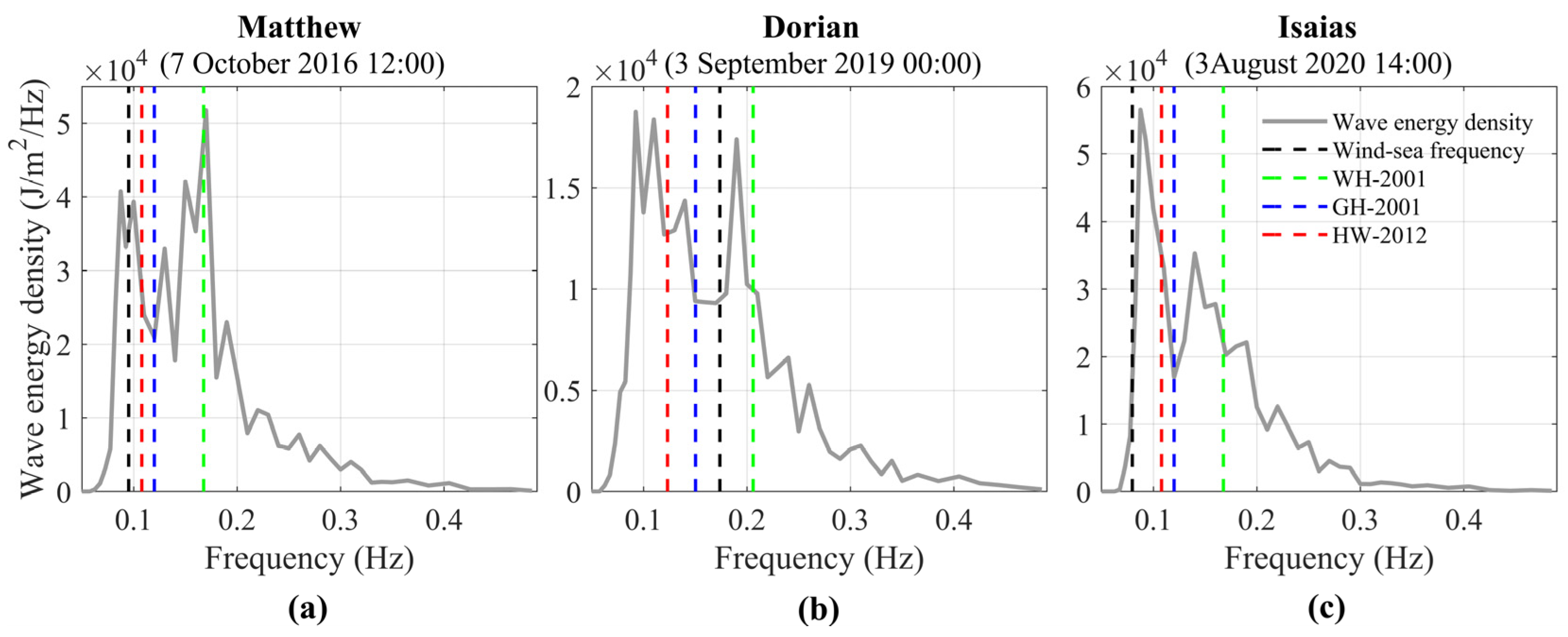


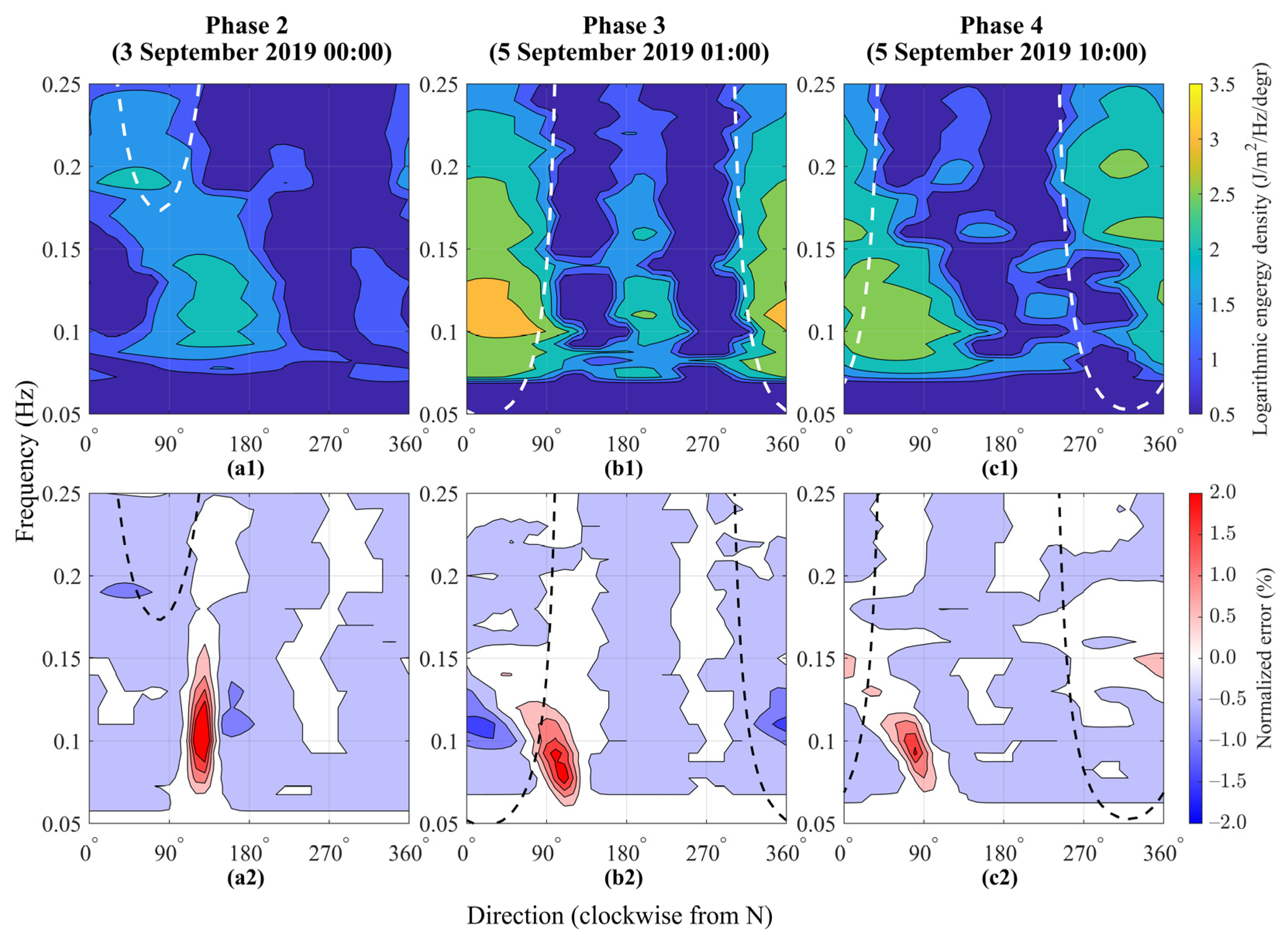
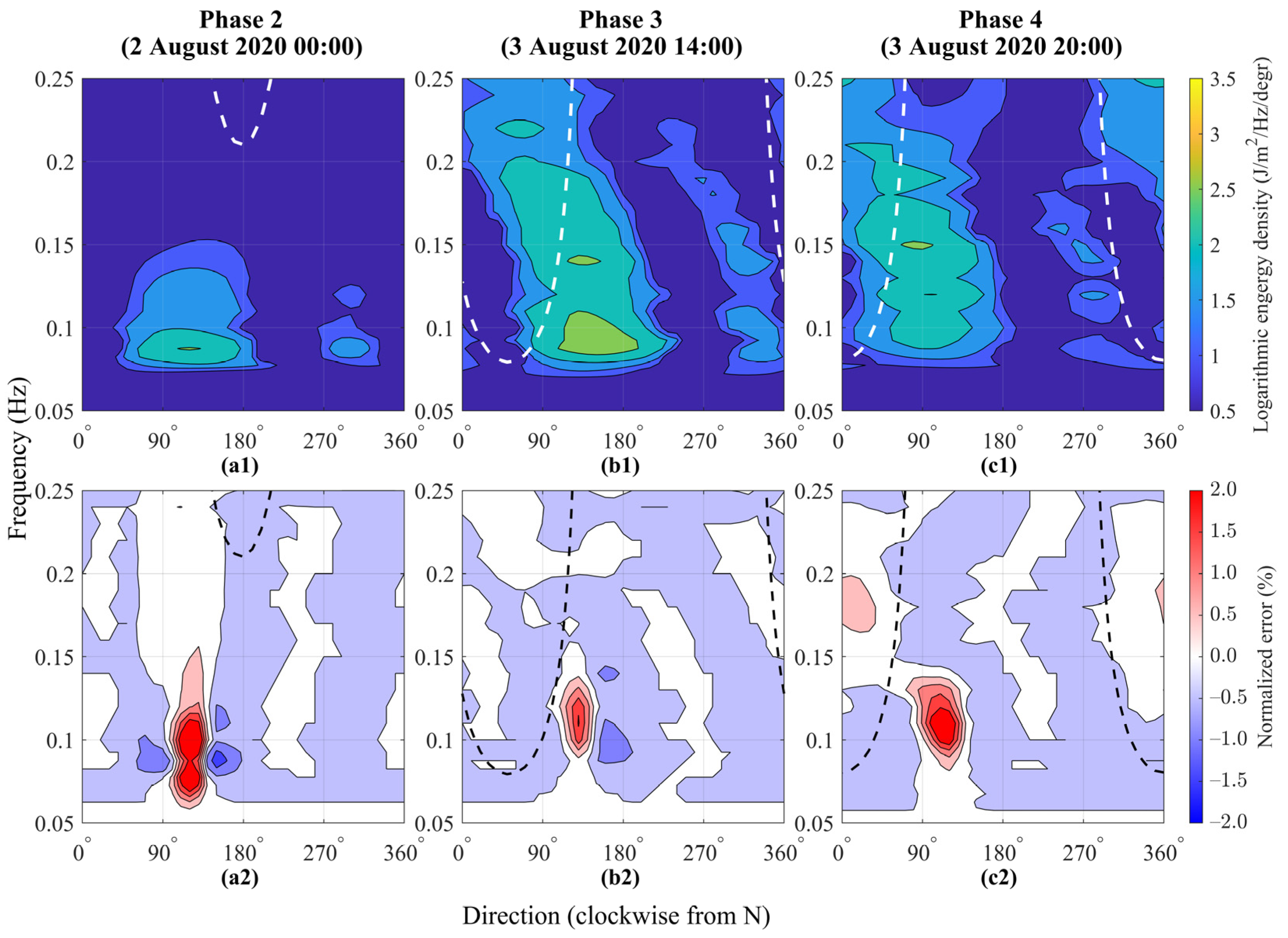
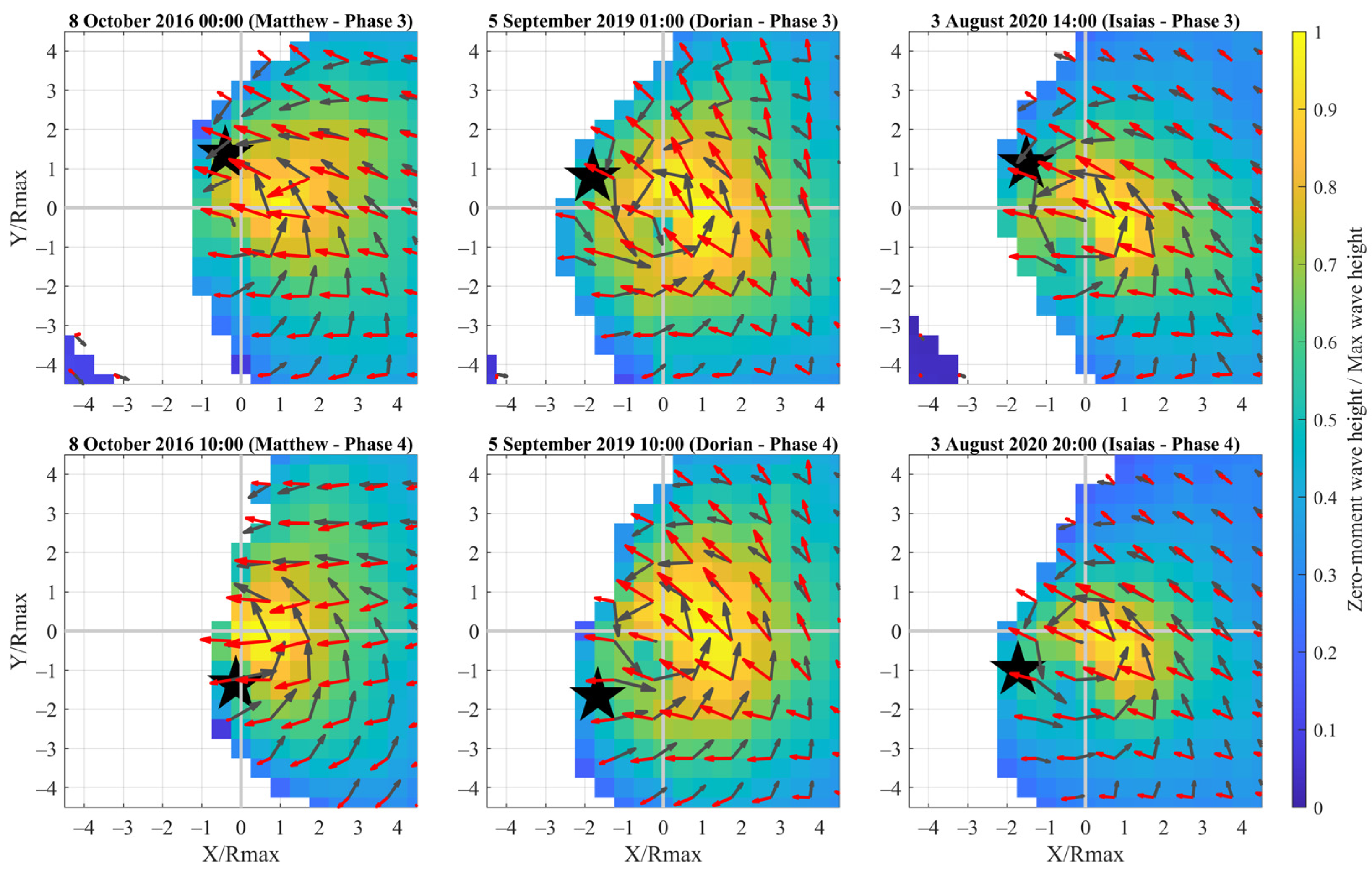
| Hurricane | ||||
|---|---|---|---|---|
| Matthew | 6.17 | 45.25 | 959.44 | 52.67 |
| Dorian | 3.27 | 58.80 | 945.36 | 35.52 |
| Isaias | 6.26 | 32.11 | 993.06 | 53.38 |
| Hurricane | ||||||
|---|---|---|---|---|---|---|
| RMSE (m) | skill | RMSE | skill | RMSE (s) | skill | |
| Matthew | 0.47 | 0.96 | 28.7 | 0.85 | 2.66 | 0.67 |
| Dorian | 0.43 | 0.97 | 35.4 | 0.86 | 3.86 | 0.56 |
| Isaias | 0.42 | 0.92 | 30.3 | 0.90 | 2.82 | 0.72 |
| Overall | 0.44 | 0.95 | 31.5 | 0.87 | 3.11 | 0.65 |
| WH–2001 | GH–2001 | HW–2012 | |
|---|---|---|---|
| 32–40% | 63–94% | 74–91% | |
| lied at local trough | 24–32% | 20–28% | 23–32% |
| TC Properties | ||||
|---|---|---|---|---|
| Correlation coefficient (R) | 0.10 | 0.13 | 0.13 | 0.10 |
| p values (p) | 0.041 | 0.009 | 0.007 | 0.052 |
Disclaimer/Publisher’s Note: The statements, opinions and data contained in all publications are solely those of the individual author(s) and contributor(s) and not of MDPI and/or the editor(s). MDPI and/or the editor(s) disclaim responsibility for any injury to people or property resulting from any ideas, methods, instructions or products referred to in the content. |
© 2023 by the authors. Licensee MDPI, Basel, Switzerland. This article is an open access article distributed under the terms and conditions of the Creative Commons Attribution (CC BY) license (https://creativecommons.org/licenses/by/4.0/).
Share and Cite
Hsu, C.-E.; Hegermiller, C.A.; Warner, J.C.; Olabarrieta, M. Ocean Surface Gravity Wave Evolution during Three Along-Shelf Propagating Tropical Cyclones: Model’s Performance of Wind-Sea and Swell. J. Mar. Sci. Eng. 2023, 11, 1152. https://doi.org/10.3390/jmse11061152
Hsu C-E, Hegermiller CA, Warner JC, Olabarrieta M. Ocean Surface Gravity Wave Evolution during Three Along-Shelf Propagating Tropical Cyclones: Model’s Performance of Wind-Sea and Swell. Journal of Marine Science and Engineering. 2023; 11(6):1152. https://doi.org/10.3390/jmse11061152
Chicago/Turabian StyleHsu, Chu-En, Christie A. Hegermiller, John C. Warner, and Maitane Olabarrieta. 2023. "Ocean Surface Gravity Wave Evolution during Three Along-Shelf Propagating Tropical Cyclones: Model’s Performance of Wind-Sea and Swell" Journal of Marine Science and Engineering 11, no. 6: 1152. https://doi.org/10.3390/jmse11061152






